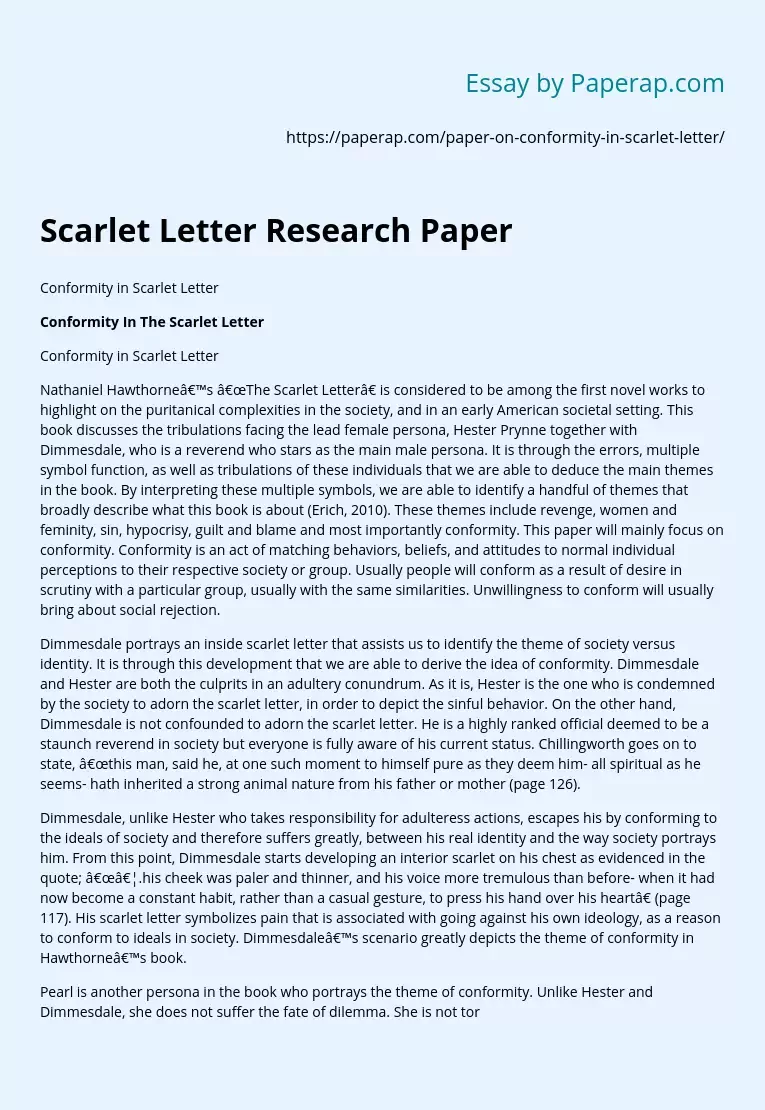Scarlet Letter Research Paper
Conformity in Scarlet Letter
Conformity In The Scarlet Letter
Conformity in Scarlet Letter
Nathaniel Hawthorne’s “The Scarlet Letter” is considered to be among the first novel works to highlight on the puritanical complexities in the society, and in an early American societal setting. This book discusses the tribulations facing the lead female persona, Hester Prynne together with Dimmesdale, who is a reverend who stars as the main male persona. It is through the errors, multiple symbol function, as well as tribulations of these individuals that we are able to deduce the main themes in the book.
By interpreting these multiple symbols, we are able to identify a handful of themes that broadly describe what this book is about (Erich, 2010). These themes include revenge, women and feminity, sin, hypocrisy, guilt and blame and most importantly conformity. This paper will mainly focus on conformity. Conformity is an act of matching behaviors, beliefs, and attitudes to normal individual perceptions to their respective society or group.
Usually people will conform as a result of desire in scrutiny with a particular group, usually with the same similarities. Unwillingness to conform will usually bring about social rejection.
Dimmesdale portrays an inside scarlet letter that assists us to identify the theme of society versus identity. It is through this development that we are able to derive the idea of conformity. Dimmesdale and Hester are both the culprits in an adultery conundrum. As it is, Hester is the one who is condemned by the society to adorn the scarlet letter, in order to depict the sinful behavior.
On the other hand, Dimmesdale is not confounded to adorn the scarlet letter. He is a highly ranked official deemed to be a staunch reverend in society but everyone is fully aware of his current status. Chillingworth goes on to state, “this man, said he, at one such moment to himself pure as they deem him- all spiritual as he seems- hath inherited a strong animal nature from his father or mother (page 126).
Dimmesdale, unlike Hester who takes responsibility for adulteress actions, escapes his by conforming to the ideals of society and therefore suffers greatly, between his real identity and the way society portrays him. From this point, Dimmesdale starts developing an interior scarlet on his chest as evidenced in the quote; “….his cheek was paler and thinner, and his voice more tremulous than before- when it had now become a constant habit, rather than a casual gesture, to press his hand over his heart” (page 117). His scarlet letter symbolizes pain that is associated with going against his own ideology, as a reason to conform to ideals in society. Dimmesdale’s scenario greatly depicts the theme of conformity in Hawthorne’s book.
Pearl is another persona in the book who portrays the theme of conformity. Unlike Hester and Dimmesdale, she does not suffer the fate of dilemma. She is not torn apart between justifying her identity clashing with her image in society. Instead, Pearl acts as a light symbol that illuminates the identity of the other two. Brought up in isolation, Pearl is relatively young and does not bear the bias that is dominant in the society. As a result, her judgment and decision making is pure consisting empathy in nature. When pearl notes that Dimmesdale is painfully clutching his chest, we are able to grasp the symbolism of conformity. Pearl pitifully says, “A strange, sad man he is, with his hand always over his heart” (page 225). Moreover, pearl highlights on Hester’s inner conflict with society and identity. Pearl perceives Hester’s action of removing the scarlet letter with relative solemn. Quote “Bright it hither!” stated Hester “Come thou and take it up!” Pearl replied (page 207).
Via the utility of multiple symbolisms, Hawthorn’s book portrays the theme of conformity. This is through bias in relation to the ideals on embracing ones identity with a view to conform to societal influences (Erich, 2010). All these intertwining symbols diligently create a brilliant model of literary art. It highlights on puritanical ideals in the society.
Reference:
Erich, G. C. (June 24, 2010). Interpreting Hawthorne: Subjectivity in Biography. Biography, 12, 2, 127-141
Scarlet Letter Research Paper. (2019, Dec 05). Retrieved from https://paperap.com/paper-on-conformity-in-scarlet-letter/

